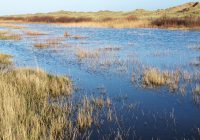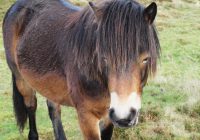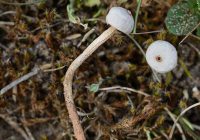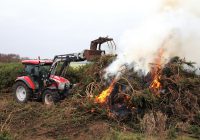Dr Phil Smith’s Wildlife Notes
December 2017
An unremarkable month for weather, December 2017 started and ended relatively mild with a cold snap in the middle. Many parts of the country had considerable snow-fall but, as usual, barely a flake was seen here. However, it was a little wetter than average with measureable rain on 20 days, though many of those had little more than a period of drizzle. Happily, the sand-dune water-table continued to rise, Devil’s Hole showing an increase of 15cm (6 inches) during the month, with surface water appearing at last in the deepest sections.
December can be a quiet month for wildlife and so it proved, though I enjoyed several successful “wild goose chases” in the first week. A flock of up to 5500 Pink-footed Geese haunted the mossland fields between Downholland and Plex, occasionally giving great views from the car. On 3rd I was lucky enough to spot a Barnacle Goose and an immature Russian Whitefront with the Pinkfeet, one of the latter being a biscuit-coloured leucistic individual. Then, on the following day, a more distant flock produced a smart adult Greenland Whitefront. This sub-species is larger and darker than its Russian counterpart with an orange, rather than pink bill. First recognised by Peter Scott, the Greenland race of Whitefronted Goose undertakes extraordinary migrations to and from its breeding grounds in western Greenland, crossing the North Atlantic and the Greenland icecap. The declining world population, now only about 20,000-strong, winters exclusively in the British Isles, mainly at Wexford in Ireland and in Western Scotland. Occasional individuals or family parties turn up annually with our Pinkfeet, some of which also breed in Greenland.
A pleasant, if cold, diversion on 11th saw me visiting Martin Mere with Joshua Styles to collect, with permission, seed and a few plants of Whorled Caraway and Tubular Water-dropwort for Josh’s North West Rare Plant Initiative. Both are Red-listed, the Wildfowl & Wetlands Trust reserve being the only site in northern England for Whorled Caraway. We tramped across the wet frozen pasture grazed by spectacular Longhorn cattle to find our prize, also spotting numerous Common Snipe, a Jack Snipe, Buzzards, Merlin and Sparrowhawk. The following day, Sands Lake was frozen apart from a small area around the island kept open by ducks which included 12 Shovelers and 18 Gadwalls, probably displaced from Marshside by the frost. A few days later, the Shovelers were still on the ice-free lake but the Gadwalls had gone.
In milder conditions just before Christmas I drove the few miles inland to Haskayne Cutting, a nature reserve that I helped to set up in 1975 with the then Lancashire Naturalists’ Trust (now the Wildlife Trust). There is always something of interest to see at this beautifully peaceful place, a refuge for wildlife in an otherwise intensively farmed landscape. An adjacent ploughed field produced an unexpected flock of 22 Pied Wagtails, with a single Grey Wagtail, while the cutting itself had a mixed flock of 10 Long-tailed Tits with Blue and Great Tits. A Chaffinch and Yellowhammer joined them, this being one of the few places in the region which the once common Yellowhammer still survives. I also had a look for bryophytes (mosses and liverworts), recording 16 species, four of which are additional to the 50 or so listed on the reserve’s database. This is quite an impressive number for such a small site.
Another excellent spot for bryophytes proved to be the area round Pinfold Pond at Ainsdale National Nature Reserve, which I visited with Joshua Styles. We recorded 26 species, two of which were new to the reserve: Lateral Cryphaea and Dotted Thyme-moss. The latter was also a new “tick” for me, as was the spectacular Greater Water-moss, one of our largest species.
Recovering from a heavy cold over Christmas, I was entertained by a reasonable selection of garden birds coming to food, including regular visits from a Song Thrush, now sadly reduced in numbers. Research suggests that its national decline since the mid-1970s is due to lower survival in the first winter, most probably due to changes in farming practice, such as land drainage and pesticide usage. I still have my little flock of House Sparrows, though their number has fallen from about 20 last winter to a dozen or so.
Exciting news from the summer came in the form of a report from two delighted Oxford entomologists who rediscovered one of the rarest British insects at Ainsdale NNR. This was the tiny Ainsdale Dung Beetle (Amoecius brevis), known only from the dunes at Birkdale and Ainsdale, where it was first recorded in 1859 and last seen in 1996. Listed as “Critically Endangered” the beetle was thought to be extinct. However, after prolonged searches, seven specimens were found associated with piles of wholesome Rabbit droppings.




